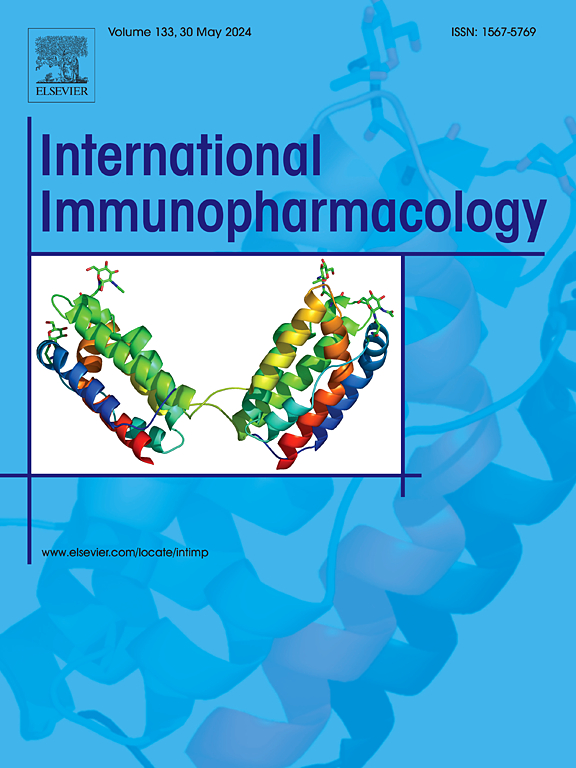TRIM29在疾病中的作用:已知的和未知的。
IF 4.8
2区 医学
Q2 IMMUNOLOGY
引用次数: 0
摘要
Tripartite motif-containing proteins (TRIMs)是E3泛素连接酶的最大亚家族,大约有80个成员,广泛分布于哺乳动物细胞中。TRIMs积极参与靶蛋白的泛素化,这是一种与蛋白质降解等功能相关的翻译后修饰。TRIM29 (Tripartite motif-containing protein 29, TRIM29)是TRIM家族的一员,与该家族的其他成员不同之处在于,它在n端缺乏含有半胱氨酸和组氨酸残基的RING finger结构域,该结构域介导DNA结合、蛋白-蛋白相互作用和泛素连接酶。TRIM29的表达最初被发现与癌症和糖尿病肾病的进展以及由病毒衍生的核酸与免疫细胞上的模式识别受体(PRRs)结合引发的抗病毒免疫有关。近年来,TRIM29也被探索作为一些免疫相关疾病的诊断生物标志物和治疗靶点。本文综述了TRIM29在疾病进展中的功能及其内在机制,以及文献中存在的空白。深入了解TRIM29的详细调控机制将最终促进针对各种疾病制定不同的治疗策略。本文章由计算机程序翻译,如有差异,请以英文原文为准。
Role of TRIM29 in disease: What is and is not known
Tripartite motif-containing proteins (TRIMs), comprising the greatest subfamily of E3 ubiquitin ligases with approximately 80 members of this family, are widely distributed in mammalian cells. TRIMs actively participate in ubiquitination of target proteins, a type of post-translational modification associated with protein degradation and other functions. Tripartite motif-containing protein 29 (TRIM29), a member of the TRIM family, differs from other members of this family in that it lacks the RING finger structural domain containing cysteine and histidine residues that mediates DNA binding, protein–protein interactions, and ubiquitin ligase, at its N-terminus. The expression of TRIM29 was initially found to be associated with cancer and diabetic nephropathy progression, and antiviral immunity which is triggered by virus-derived nucleic acids binding to pattern recognition receptors (PRRs) on immune cells. Recently, TRIM29 has also been explored as a diagnostic biomarker and therapeutic target for some immune-related diseases. Here, we review the functions of TRIM29 in the progression of diseases and the inherent mechanisms, as well as the remaining gaps in the literature. A thorough understanding of the detailed regulatory mechanisms of TRIM29 will ultimately facilitate the development of different therapeutic strategies for various diseases.
求助全文
通过发布文献求助,成功后即可免费获取论文全文。
去求助
来源期刊
CiteScore
8.40
自引率
3.60%
发文量
935
审稿时长
53 days
期刊介绍:
International Immunopharmacology is the primary vehicle for the publication of original research papers pertinent to the overlapping areas of immunology, pharmacology, cytokine biology, immunotherapy, immunopathology and immunotoxicology. Review articles that encompass these subjects are also welcome.
The subject material appropriate for submission includes:
• Clinical studies employing immunotherapy of any type including the use of: bacterial and chemical agents; thymic hormones, interferon, lymphokines, etc., in transplantation and diseases such as cancer, immunodeficiency, chronic infection and allergic, inflammatory or autoimmune disorders.
• Studies on the mechanisms of action of these agents for specific parameters of immune competence as well as the overall clinical state.
• Pre-clinical animal studies and in vitro studies on mechanisms of action with immunopotentiators, immunomodulators, immunoadjuvants and other pharmacological agents active on cells participating in immune or allergic responses.
• Pharmacological compounds, microbial products and toxicological agents that affect the lymphoid system, and their mechanisms of action.
• Agents that activate genes or modify transcription and translation within the immune response.
• Substances activated, generated, or released through immunologic or related pathways that are pharmacologically active.
• Production, function and regulation of cytokines and their receptors.
• Classical pharmacological studies on the effects of chemokines and bioactive factors released during immunological reactions.

 求助内容:
求助内容: 应助结果提醒方式:
应助结果提醒方式:


